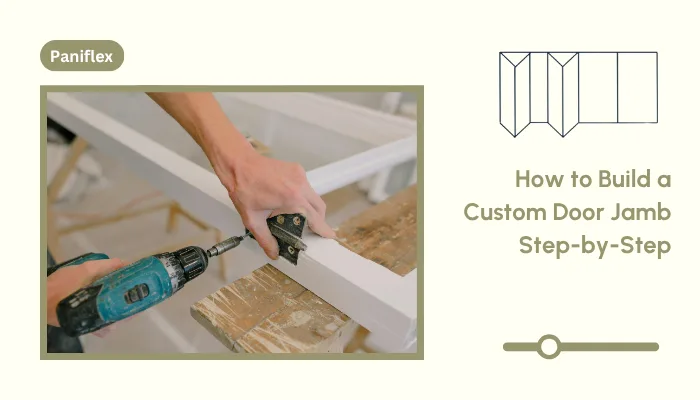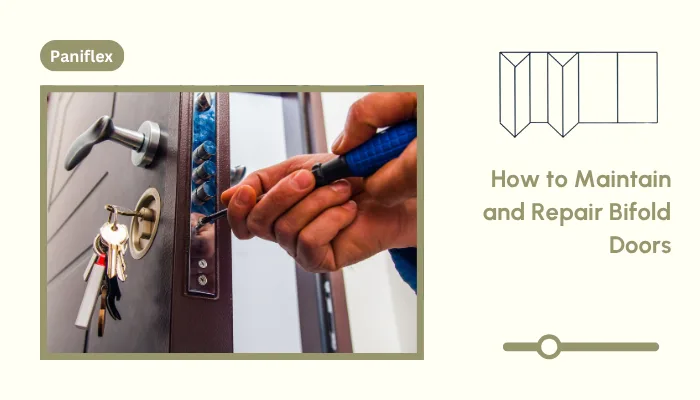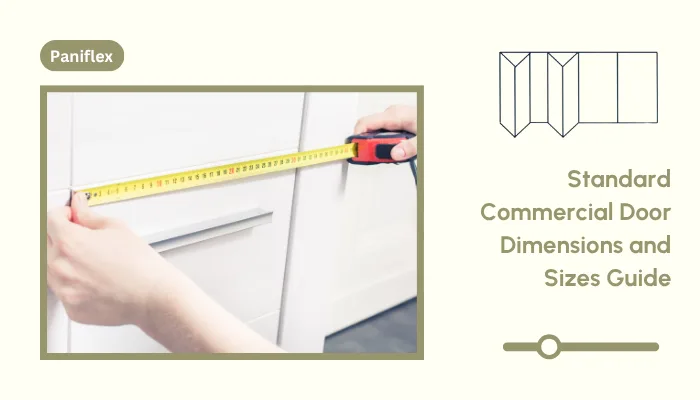A door jamb may seem like a minor detail, but it plays a critical role in the strength, alignment, and visual appeal of any doorway. Building a custom door jamb is often necessary when dealing with non-standard openings, unique design requirements, or older structures where precision is key.
We understand how frustrating it can be when standard jambs do not fit perfectly, leaving gaps or uneven edges that compromise the finished look. This step-by-step guide will help you craft a custom door jamb that meets both structural and design demands with professional results.
Ready to experience the benefits of custom closet doors? Explore our range of Paniflex products now.
TL;DR
- A door jamb provides structural support, ensures proper alignment, and adds a finished look to doors in residential and commercial spaces.
- Building a custom jamb requires precise measuring, high-quality materials, and careful assembly to ensure a perfect fit.
- Common mistakes include making inaccurate cuts, skipping squareness checks, and failing to account for wall thickness or shimming requirements.
- Regular maintenance and the use of durable materials help ensure the longevity and performance of custom-built door jambs.
What Is a Custom Door Jamb and Why Is It Important?
A door jamb is a framework that forms the vertical and horizontal sides of a doorway, supporting the door and allowing it to swing or slide smoothly. It anchors the door, ensures proper alignment, and contributes to the overall stability and appearance of the opening.
These are a few reasons to get a custom door jamb:
- Structural support: Holds the door securely and distributes weight to prevent sagging.
- Alignment and fit: Ensures the door closes smoothly and flush without gaps or sticking.
- Finish: Provides a clean edge for casing and trim, enhancing the appearance of the doorway.
- Weatherproofing and soundproofing: Acts as a base for seals and weatherstripping in exterior applications.
With the role of a door jamb clear, it is equally important to understand the different types available and where each is best applied. The next section explores common door jamb styles and their applications in various projects.
Suggested Watch: This video demonstrates how to build a custom door jamb when hanging a salvaged door.
Types of Door Jambs and Their Applications
Selecting the correct type of door jamb is crucial for both functionality and design compatibility. Each type serves specific purposes, and understanding these options helps in choosing the best fit for any project.
These are the common door jamb types and uses:
- Flat Jamb: A simple, rectangular frame ideal for interior doors where casing or trim will be added later for a clean, finished look. Commonly used in modern residential projects.
- Rabbeted Jamb: Includes a built-in stop for the door to rest against, simplifying installation and enhancing sealing. Ideal for exterior doors that require weatherproofing or acoustic performance.
- Split Jamb: Designed for walls with varying thicknesses, this jamb type allows adjustment during installation and is ideal for renovations or non-standard openings in older structures.
- Applied Stop Jamb: Features a separate stop molding applied after installation, offering flexibility for custom hardware or door thickness adjustments in both commercial and residential applications.
- Double Rabbeted Jamb: Accommodates double doors or thicker panels, providing additional support and a flush, symmetrical appearance for larger openings, such as lobbies or conference rooms.
Once you have determined the right jamb type, it is time to gather the proper tools and materials. The next section covers everything you will need to build a custom door jamb efficiently.
Tools and Materials Needed to Build a Custom Door Jamb
Building a custom door jamb requires more than just woodworking skills. It demands the right tools and materials to ensure precision and durability. Preparing these in advance helps streamline the process and prevents costly mistakes during installation.
| Tool/Material | Description |
| Measuring Tape | For accurate measurements of door opening dimensions, ensuring a precise fit. |
| Circular Saw or Miter Saw | This is used to cut pieces cleanly and to the exact required lengths. |
| Carpenter’s Square | Helps ensure all cuts and assembled jamb corners are perfectly square. |
| Level | Essential for checking the alignment of jambs during fitting and installation. |
| Wood Stock (Jamb Material) | Solid wood or engineered boards are chosen to suit the project’s design and needs. |
| Nails or Screws | Used for assembling the jamb and securing it within the rough opening. |
| Wood Glue | Adds extra strength to joints during assembly. |
| Shims | For leveling and adjusting the jamb within uneven wall openings. |
| Sandpaper or Sander | This smoothes edges and surfaces before painting or staining. |
| Primer and Paint/Stain | For finishing the jamb to match or complement the door and surrounding trim. |
With tools and materials ready, the next step is careful preparation. Proper measurements and planning are critical to building a custom door jamb that fits perfectly and performs as expected.
Suggested Read: How to Fix a Large Gap Under the Door?
Preparing for the Build: Measurements and Planning
A successful custom door jamb starts with precise measurements and thorough planning. This step ensures that the finished jamb fits perfectly within the door opening, preventing installation issues and supporting the door’s long-term performance.
Step 1: Measure the Door Opening Accurately
Use a measuring tape to record the height and width of the rough opening at multiple points (top, middle, bottom). Account for any irregularities or out-of-square frames to avoid gaps during installation.
Step 2: Determine the Required Jamb Width
Measure the wall thickness, including drywall or plaster, to calculate the correct jamb depth. Consider additional layers like tile or paneling if the door will be installed in a finished space.
Step 3: Plan for Casing and Trim
Decide on the casing or trim style and thickness. This affects how much of the jamb will be visible and helps maintain a seamless transition between door and wall surfaces.
Step 4: Choose Appropriate Materials
Select wood or engineered boards that are suited to the environment (e.g., moisture-resistant materials for bathrooms or exterior use). Quality materials reduce the risk of warping and extend the life of the jamb.
With precise measurements and careful planning in place, you are ready to begin the construction process. The next section provides a detailed step-by-step guide to building a custom door jamb.
From the Community: This Reddit thread explains how to build a door frame and jamb.
Step-by-Step Guide to Building a Custom Door Jamb
Once your measurements and materials are ready, you can begin building the custom door jamb. Follow these steps carefully to ensure a strong, precise, and professional-quality installation.
- Cut the jamb pieces to size: Measure and cut the head jamb and side jambs using a circular or miter saw. Check all cuts for accuracy to avoid alignment issues later.
- Assemble the jamb frame: Arrange the head jamb between the two side jambs in a U-shape. Apply wood glue to the joints and secure them with screws or nails for a strong connection.
- Check for squareness: Use a carpenter’s square to ensure the frame is perfectly square before moving on. Correct any misalignments at this stage to prevent future operational problems.
- Dry-fit the jamb in the opening: Place the assembled frame into the rough opening. Use shims to level and plumb the area, and mark any areas that may require slight adjustments.
- Install the jamb securely: Fasten the jamb into place with nails or screws, maintaining level and plumb alignment throughout the process. Recheck squareness as you work to ensure precision.
- Add casing and finish: Attach trim or casing for a clean, finished look. Sand rough edges and apply primer, paint, or stain to protect and enhance the appearance of the jamb.
Avoiding common mistakes is just as important as following the steps. The next section outlines key errors to watch for when building a door jamb and guides how to prevent them.
Suggested Read: How to Install Bifold Door Snugger: A Basic Guide
Common Mistakes to Avoid When Building a Door Jamb
Even experienced professionals can run into challenges when constructing a custom door jamb. Awareness of common mistakes and how to correct them can save time and materials, ensuring a professional-quality result that holds up over time.
1. Cutting Inaccurate Measurements
Rushing measurements or failing to check for out-of-square openings often results in gaps and a poor fit. Always measure at multiple points (top, middle, bottom) to account for irregularities. Double-check all cuts before assembly to avoid wasted materials. Using a quality measuring tape and square can prevent most sizing errors.
2. Skipping the Squareness Check
A jamb frame that is even slightly out of square will cause the door to stick or fail to close properly. After assembling the frame, use a carpenter’s square to confirm right angles. Adjust joints before the glue sets or screws are fully tightened. This small step prevents alignment issues during the installation process.
3. Failing to Account for Wall Thickness
Overlooking drywall or additional wall finishes can result in a jamb that is too shallow or too deep. Measure total wall thickness carefully, including tile, paneling, or plaster. Select wood stock that matches this depth or adjust during assembly. This ensures the jamb sits flush and supports trim or casing correctly.
4. Ignoring the Importance of Shims
Installing a jamb without proper shimming can leave it out of level or plumb, leading to uneven gaps around the door. Always use shims during dry-fit and installation to fine-tune positioning. Check alignment at each stage using a level. This practice creates a solid, square foundation for the door.
Once you know what to avoid, a few professional techniques can elevate your installation from functional to flawless. The next section shares pro tips for building custom door jambs with precision and confidence.
Suggested Read: Guide To Sizing A Rough Opening For Bifold Doors
Pro Tips for a Flawless Custom Jamb Installation
Attention to detail is what separates a basic installation from one that looks and functions like a seasoned professional would have done it. These tips can help contractors, interior designers, and architects achieve precise, long-lasting results on every project.
- Pre-finish components before assembly: Sand, prime, and paint or stain jamb pieces before installation to achieve cleaner edges and avoid accidental paint marks on walls.
- Account for seasonal wood movement: Leave a slight expansion gap between the jamb and framing to accommodate humidity changes without causing warping or cracking.
- Use construction adhesive along with fasteners: This provides extra strength and prevents creaking in high-traffic areas or commercial applications.
- Check plumb and level at every stage: Use a quality level and adjust shims as needed to maintain perfect alignment from start to finish.
- Test-fit the door early: Hang the door temporarily during the dry fit to ensure smooth operation and identify any issues before final fastening.
While installation technique is key, choosing the right wood or material for your custom jamb is equally important. The next section explores material options to help you make the best choice for your project’s requirements.
Choosing the Right Wood or Material for a Custom Jamb
The material you select for a door jamb plays a critical role in its durability, appearance, and performance. For custom projects, selecting the right wood or engineered option ensures the jamb aligns with both functional requirements and design expectations.
Solid wood remains a popular choice for its strength and natural beauty, making it ideal for high-end residential and historic restoration projects. Engineered wood, also known as MDF, provides cost-effective solutions for interior applications and resists warping in controlled environments.
For exterior doors or areas with high humidity, moisture-resistant hardwoods like oak or treated materials provide added protection against swelling and decay. Always match the material to the door type, usage frequency, and environmental conditions.
While material selection is important, another key decision is whether to use a pre-hung door or build your own jamb. The next section compares both options to help you determine the best approach for your project.
Pre-Hung Doors vs Building Your Own Jamb
Choosing between a pre-hung door and building a custom jamb depends on your project’s needs, timeline, and level of customization. Both approaches have unique advantages, and understanding their differences helps in making the right decision for any space.
Comparison Table: Pre-Hung vs Custom Jamb
| Feature | Pre-Hung Doors | Custom-Built Jambs |
| Installation Time | Faster, ready for fitting | Longer, built on site |
| Precision Fit | Standard sizes, limited fit | Perfect for non-standard openings |
| Customization | Limited design flexibility | Fully customizable to design |
| Material Options | Often predefined selections | Wide range of material choices |
| Cost | More economical upfront | Higher labor and material cost |
When precision and tailored solutions are essential, partnering with an experienced manufacturer can simplify the process. That is where Custom Door & Mirror offers expertise in delivering precision-fit door jambs and doors for any project.
Why Choose Custom Door & Mirror?
When precision, quality, and design flexibility matter, Custom Door & Mirror stands out as a trusted partner for contractors, interior designers, and architects. Their commitment to craftsmanship ensures every custom door jamb and bifold door is built to exacting standards.
Key Features of Custom Door & Mirror:
- Precision Engineering for Flawless Fit: Every door and jamb is crafted to exact specifications, ensuring a perfect fit even in non-standard openings. This eliminates alignment issues and saves time during the installation process.
- Premium Materials and Finishes: They offer a range of durable materials and elegant finishes to complement any design vision. Whether for residential or commercial spaces, their products combine functionality with looks.
- Custom Solutions for Unique Projects: From historic restorations to modern high-ceiling designs, their team delivers tailored solutions that meet complex architectural requirements. No detail is too small to be perfected.
- Expert Guidance and Support: Their professionals work closely with clients to ensure the right product selection, simplifying decision-making for complex projects. This collaborative approach reduces errors and enhances efficiency.
- Long-Lasting Durability: Built to withstand daily use in demanding environments, their doors and jambs maintain structural integrity and appearance for years, adding value to any project.
With decades of experience and a focus on quality, Custom Door & Mirror offers door solutions that seamlessly blend technical excellence with design appeal. Their expertise enables professionals to achieve superior results, regardless of the project’s complexity.
Ready to experience the benefits of custom closet doors? Explore our range of Paniflex products now.
Conclusion
Building a custom door jamb requires precision, planning, and the right techniques to ensure a flawless fit and long-lasting performance. From understanding the types of door jambs to selecting quality materials and avoiding common mistakes, this guide equips professionals with the knowledge to deliver exceptional results on every project.
For contractors, interior designers, and architects seeking expertly crafted door solutions, Custom Door & Mirror offers unmatched precision and durability. Their custom-made jambs and doors are designed to meet both appearance and functional demands, making them a trusted partner for projects of any scale.
Contact us today to discover precision-fit door solutions that enhance your workflow.
Frequently Asked Questions
- What material should be used for a door jamb?
Solid wood, such as oak or pine, is ideal for its strength and durability. MDF or engineered wood works for interiors. For exterior doors, moisture-resistant or treated wood helps prevent warping and decay over time.
- How do you make a simple door frame from scratch?
Measure the opening precisely, cut the jamb pieces to size, assemble them in a U-shape with glue and screws, check for squareness, dry-fit them in the opening, shim for level, and secure them with nails before adding the casing or trim.
- What is the difference between a door jamb and a door frame?
A door jamb is part of the door frame—the vertical and horizontal components that hold the door in place. The door frame consists of the jamb, casing, sill (if applicable), and stops, all assembled as a complete unit.
- How thick should my door jamb be?
The door jamb thickness should match the total wall thickness, including the thickness of the drywall or paneling. Standard interior walls require 4 9/16 inches, while exterior walls often need 6 9/16 inches for proper fit and support.






